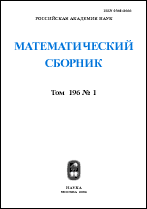|
This article is cited in 20 scientific papers (total in 20 papers)
Non-autonomous Ginzburg–Landau equation and its attractors
M. I. Vishik, V. V. Chepyzhov
Institute for Information Transmission Problems, Russian Academy of Sciences
Abstract:
The behaviour as $t\to+\infty$ of solutions $\{u(x,t),\ t\geqslant0\}$ of the non-autonomous Ginzburg–Landau (G.–L.) equation is studied. The main attention is focused on the case when the dispersion coefficient $\beta(t)$ in this equation satisfies the inequality $|\beta(t)|>\sqrt3$ for $t\in L$, where $L$ is an unbounded subset of $\mathbb R_+$. In this case the uniqueness theorem for the G.–L. equation is not proved. The trajectory attractor $\mathfrak A$ for this equation is constructed.
If the coefficients and the exciting force are almost periodic (a.p.) in time and the uniqueness condition fails, then the trajectory attractor $\mathfrak A$ is proved to consist precisely of the solutions $\{u(x,t),\ t\geqslant0\}$ of the G.-L. equation that admit a bounded extension as solutions of this equation onto the entire time axis $\mathbb R$.
The behaviour as $t\to+\infty$ of solutions of a perturbed G.–L. equation with coefficients and the exciting force that are sums of a.p. functions and functions approaching zero in the weak sense as $t\to+\infty$ is also studied.
Received: 15.10.2004
Citation:
M. I. Vishik, V. V. Chepyzhov, “Non-autonomous Ginzburg–Landau equation and its attractors”, Sb. Math., 196:6 (2005), 791–815
Linking options:
https://www.mathnet.ru/eng/sm1363https://doi.org/10.1070/SM2005v196n06ABEH000901 https://www.mathnet.ru/eng/sm/v196/i6/p17
|


| Statistics & downloads: |
| Abstract page: | 755 | | Russian version PDF: | 214 | | English version PDF: | 61 | | References: | 79 | | First page: | 3 |
|




 Contact us:
Contact us: Terms of Use
Terms of Use
 Registration to the website
Registration to the website Logotypes
Logotypes








 Citation in format
Citation in format 
